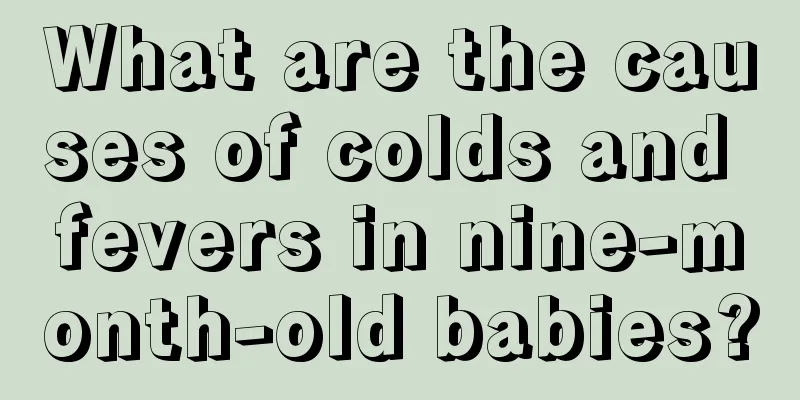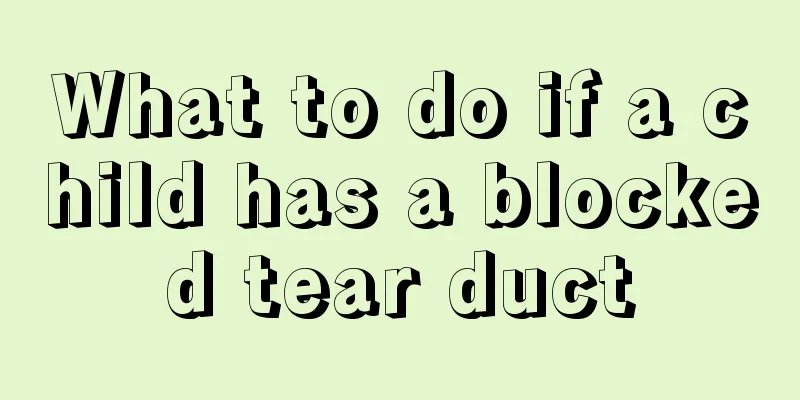What are the causes of colds and fevers in nine-month-old babies?

|
There are many babies under one year old who are particularly prone to colds and fevers due to their poor physical fitness. Colds and fevers can cause great harm to the baby's health, so parents should pay attention to them. When the child has a fever or cold, they can recover through treatment. The following content specifically introduces the causes of colds and fevers in 9-month-old babies. Parents can have a comprehensive understanding. Causes of colds in nine-month-old children 80% to 90% of colds are caused by viruses, and there are more than 200 types of viruses that can cause colds; 10% to 20% of colds are caused by bacteria. Babies under one year old are more susceptible to colds because their immune systems are not yet fully developed. Children are prone to catching colds, primarily because of their physiological and anatomical characteristics and the immaturity of their immune systems. Children's nasal cavity is narrow, the mucosa is tender, the mucosal glands secrete insufficiently and are relatively dry. They have poor adaptability and resistance to the external environment and are prone to inflammation. Premature babies, children with congenital defects or diseases, such as heart and lung failure, and especially those with congenital immune diseases, may catch a cold if there is any mistake in care. Key points of syndrome differentiation for children's cold Features (1) Children cannot adjust to cold or heat by themselves, their skin is thin, their defenses are weak, and they are easily attacked by external pathogens and become ill. (2) Children’s bodies are pure Yang, with excess Yang and insufficient Yin. When they are infected by pathogens, the disease spreads rapidly. The six pathogenic Qi are all transformed from fire and quickly enter the exterior and interior, causing the same disease symptoms. (3) Children’s lungs are delicate, their spleens are often deficient, but their liver qi is abundant. They are timid and weak, and when they are infected by pathogens, they are prone to symptoms such as phlegm, stagnation, and shock. 2. Classification (1) Wind-cold type: aversion to cold, fever, no sweating, stuffy nose, runny nose, sneezing, cough, thin sputum, no thirst, thin white tongue coating, floating and tight pulse (2) Wind-heat type: severe heat and mild cold, with sweating, headache, nasal congestion and runny yellow nasal discharge, cough with yellow sputum, sore throat, dry mouth, thin white or thin yellow tongue coating, and floating and rapid pulse. (3) Heat syndrome type: high fever without sweating, headache, heaviness and drowsiness, chest tightness and nausea, loss of appetite, or nasal congestion, runny nose, cough, red tongue, thin white or greasy tongue coating, and rapid pulse. (4) Combined syndrome type: 1. Phlegm; 2. Stagnation; 3. Shock. (Related syndrome differentiation omitted). There are many causes of colds and fevers in nine-month-old babies, so as parents, when your child has a cold and fever, you must first understand what type of cold it is. Only by understanding it can you use the correct medication to make the child recover as soon as possible. So when parents find that their children have a cold and fever, they must first go to the hospital for a comprehensive examination to confirm the type of cold and then treat it, which will have a better treatment effect. |
<<: Is it good for children to sleep more when they have a fever?
>>: How to treat ringworm on baby's face?
Recommend
Taboos of pediatric massage, relevant matters must be kept in mind
Massage therapy can be used to treat some disease...
How many months does the baby start to see things?
How many months does it take for a baby to be abl...
Children with diarrhea should be cautious when using 5 types of drugs
Diarrhea is prevalent in summer, especially among...
Why does my child blink so frequently?
Blinking is a normal physiological reaction of th...
What to do if the baby does not drink boiled water
The most common drink in daily life is boiled wat...
What is the normal crp value for children?
Many people do not know the meaning of crp. In fa...
What factors affect bone growth?
Every parent hopes that their children can grow t...
Should I be worried about white spots on my newborn's gums?
Many characteristics of newborns are not obvious,...
Diet therapy for purple fingernails in newborns
In fact, in daily life, some people who have just...
What causes nosebleeds in children?
Children's noses always bleed, which makes ma...
The color of your stool as jaundice subsides
The color of stool will also change during the pe...
Treatment of red spots on baby's body
Many babies have red spots on their bodies. When ...
Baby diarrhea green foam
The baby's body should be protected. They may...
How should I bask in the sun if I have jaundice?
As long as the baby's jaundice is not serious...
How to wash the butt of a newborn
The buttocks of newborn babies are delicate and s...









